Giorgio De Marchis, Visioni, in 23. Bienal Internacional São Paulo (cat.), Fundação Bienal de São Paulo, São Paulo 1/3
On the subject of the dematerialization of art, which is the theme of the 23rd International Art Biennale of San Paolo for which Umberto Cavenago was selected, it is impossible not to forget that at the 1959 Biennale Lucio Fontana exhibited his first «cuts», monochrome canvases in which, holding a blade, the artist produced with a quick and dry gesture one or two vertical or oblique slits. It was an opening in the two-dimensional screen of the canvas, the traditional support of painting, a passage that went beyond, with an act that no longer produced an object of art, but, by destroying or abolishing its premises, constituted itself as the beginning of a new cognitive experience, entirely mental.
The same instantaneousness of the gesture of breaking the surface seemed to correspond to the instantaneousness of thought.
Fontana’s work, whose early Futurist precedents should not be forgotten, was an important contribution to the conceptualism and experimentalism that dominated Italian and European art for more than three decades, despite anachronistic regurgitations favored by a dyspeptic critique. That in Italy they have yielded considerable fruits seems to me to be a fact based on a very old tradition if Leonardo, in whose thought scientific and artistic speculation coexisted, asserted: «painting is a mental thing».
Giorgio De Marchis, Visioni, in 23. Bienal Internacional São Paulo (cat.), Fundação Bienal de São Paulo, São Paulo 2/3
Umberto Cavenago, whom we chose to represent Italy at the 1996 Biennale, is a new generation Italian artist, graduated in architecture and quickly established himself internationally as a sculptor. But he is also a computer enthusiast who knows everything and does everything with it.
The work specifically created for the São Paulo Biennale is entitled Visioni and subtitled with a phrase by William Blake: “All men are capable of dreaming and having visions”. It consists of a dark, practicable space at the entrance of which a table, representing the place of thought and design, carries a computer screen inserted on the flat horizontal surface, which occupies the place where a piece of paper would be placed for writing or drawing. A composite image appears on the screen, i.e. a set of images as large as stamps that are the initial frames of video footage taken under conditions of mobility and change in various locations and personal occasions of Cavenago himself and left as a succession of fragments without editing. The same set of images appears enlarged on a large screen placed on the wall in front. By resting his hand, that is, by touching one or other of the images appearing on the table, the visitor sets in motion the projection of the video recording, which will also appear enlarged on the front screen. In this way, what the individual visitor sets in motion with the private gesture of his action on the table becomes public to the other visitors in the projection on the large background screen. The places of Cavenago, by choice, are populated with visitors.
Partito Preso at Galleria Nazionale d’Arte Moderna, Rome 1/3
As part of an initiative promoted by Galleria Nazionale d’Arte Moderna in Rome entitled Partito Preso, in which works by young artists are presented, Umberto Cavenago has exhibited his work: Visioni.
The work is an anticipation of a much larger project that the artist, invited by the same Roman museum to represent Italy at the 23rd Biennale of São Paulo in Brazil, elaborated on the theme proposed this year: “the dematerialization of art at the end of the millennium”.
Antonella Soldaini
Partito Preso alla Galleria Nazionale d’Arte Moderna, Roma 3/3
Visioni consists of a series of digitalised images depicting urban landscapes in which sculptures made between the 19th and 20th centuries can be seen.
The observer is given the opportunity to alter these images and the way to do this is to place, by using a mouse, the pointer that appears on the computer screen exactly on one of the reproduced sculptures and to “click”. Thanks to this simple action we will witness virtual dematerialization. The sculptures will slowly disappear and what remains in the end is the vision of the space where they were inserted as they should have been before the artistic intervention. In this way, Cavenago seems to have taken to the letter the problem of “dematerialization” suggested by the Biennale di San Paolo, taking the concept to the extreme and implementing a radical gesture: that of making visible in a paradoxical and ironic way the implementation (albeit only virtually) of a real suppression.
By pointing the arrow at the works and interacting with the computer we become accomplices of a terrorist plan, living at the same time a moment of great liberation. One after the other, sculptures with monumental pomp of the nineteenth century, or the more modern ones with a terribly pretentious appearance, disappear before our eyes and give way to a space that regains its original shape.
Visioni is a desecrating work that joyfully dismantles a mental process to which one has become accustomed and whose inadequacy few artists seem to begin to realize. Located inside a museum, the Galleria Nazionale d’Arte Moderna in Rome, whose bulky and triumphalistic architecture is in itself an example of monumentalism driven to excesses, the work of the Milanese artist, conceptually constitutes a real attack on everything that surrounds him and obliges a total revision of his expressive research. As we watch sculptures disappear, we are imbued with a subtle pleasure that impels us to go beyond our limits of tolerance and to question all our concepts concerning private and public commissioning, art and politics, sculpture and territory.
Antonella Soldaini
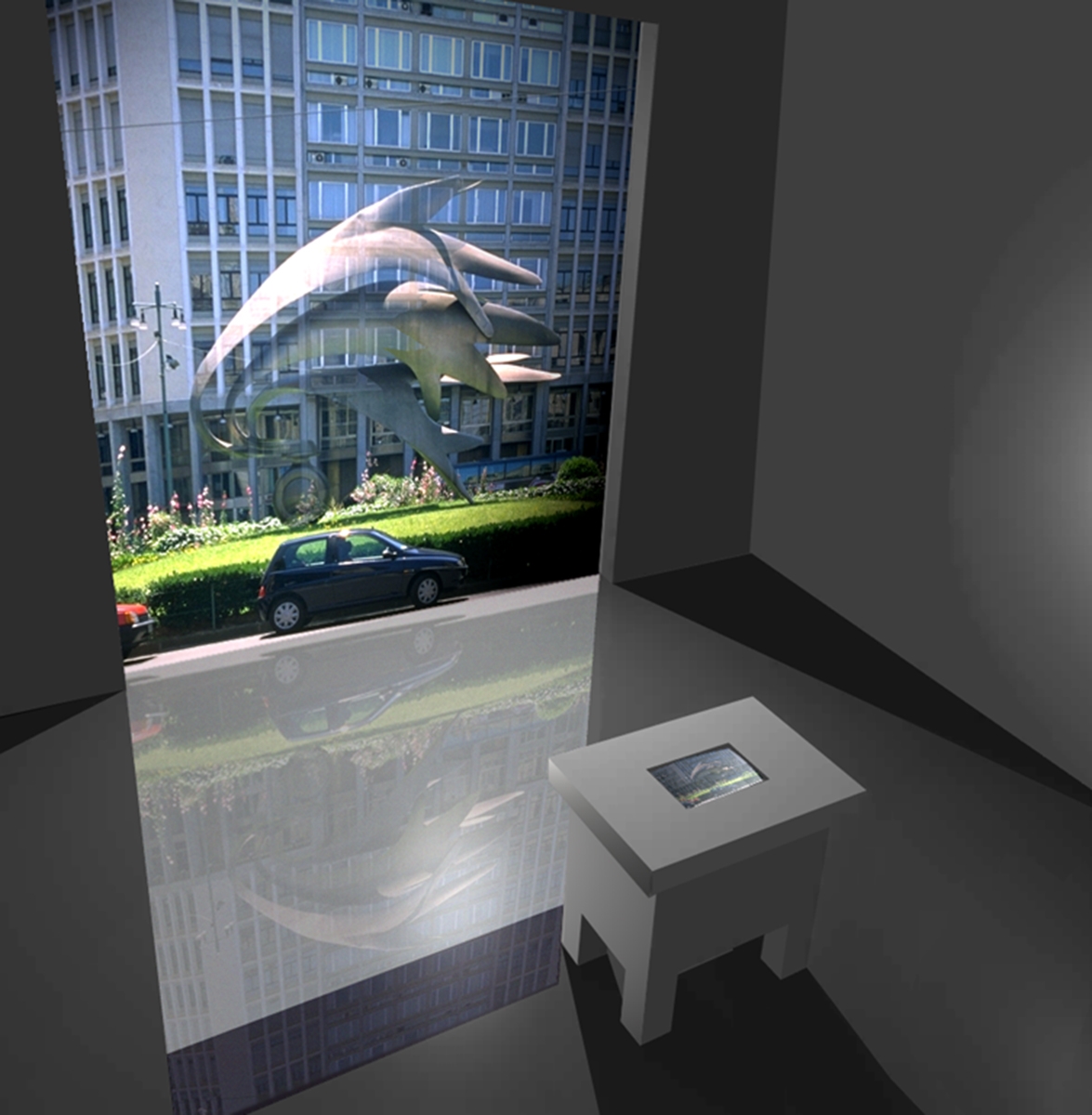
Three-dimensional modeling of the exhibition space
Giorgio De Marchis, Visioni, in 23. Bienal Internacional São Paulo (cat.), Fundação Bienal de São Paulo, São Paulo 1/3
On the subject of the dematerialization of art, which is the theme of the 23rd International Art Biennale of San Paolo for which Umberto Cavenago was selected, it is impossible not to forget that at the 1959 Biennale Lucio Fontana exhibited his first «cuts», monochrome canvases in which, holding a blade, the artist produced with a quick and dry gesture one or two vertical or oblique slits. It was an opening in the two-dimensional screen of the canvas, the traditional support of painting, a passage that went beyond, with an act that no longer produced an object of art, but, by destroying or abolishing its premises, constituted itself as the beginning of a new cognitive experience, entirely mental.
The same instantaneousness of the gesture of breaking the surface seemed to correspond to the instantaneousness of thought.
Fontana’s work, whose early Futurist precedents should not be forgotten, was an important contribution to the conceptualism and experimentalism that dominated Italian and European art for more than three decades, despite anachronistic regurgitations favored by a dyspeptic critique. That in Italy they have yielded considerable fruits seems to me to be a fact based on a very old tradition if Leonardo, in whose thought scientific and artistic speculation coexisted, asserted: «painting is a mental thing».
Giorgio De Marchis, Visioni, in 23. Bienal Internacional São Paulo (cat.), Fundação Bienal de São Paulo, São Paulo 2/3
Umberto Cavenago, whom we chose to represent Italy at the 1996 Biennale, is a new generation Italian artist, graduated in architecture and quickly established himself internationally as a sculptor. But he is also a computer enthusiast who knows everything and does everything with it.
The work specifically created for the São Paulo Biennale is entitled Visioni and subtitled with a phrase by William Blake: “All men are capable of dreaming and having visions”. It consists of a dark, practicable space at the entrance of which a table, representing the place of thought and design, carries a computer screen inserted on the flat horizontal surface, which occupies the place where a piece of paper would be placed for writing or drawing. A composite image appears on the screen, i.e. a set of images as large as stamps that are the initial frames of video footage taken under conditions of mobility and change in various locations and personal occasions of Cavenago himself and left as a succession of fragments without editing. The same set of images appears enlarged on a large screen placed on the wall in front. By resting his hand, that is, by touching one or other of the images appearing on the table, the visitor sets in motion the projection of the video recording, which will also appear enlarged on the front screen. In this way, what the individual visitor sets in motion with the private gesture of his action on the table becomes public to the other visitors in the projection on the large background screen. The places of Cavenago, by choice, are populated with visitors.
Partito Preso at Galleria Nazionale d’Arte Moderna, Rome 1/3
As part of an initiative promoted by Galleria Nazionale d’Arte Moderna in Rome entitled Partito Preso, in which works by young artists are presented, Umberto Cavenago has exhibited his work: Visioni.
The work is an anticipation of a much larger project that the artist, invited by the same Roman museum to represent Italy at the 23rd Biennale of São Paulo in Brazil, elaborated on the theme proposed this year: “the dematerialization of art at the end of the millennium”.
Antonella Soldaini
Partito Preso alla Galleria Nazionale d’Arte Moderna, Roma 3/3
Visioni consists of a series of digitalised images depicting urban landscapes in which sculptures made between the 19th and 20th centuries can be seen.
The observer is given the opportunity to alter these images and the way to do this is to place, by using a mouse, the pointer that appears on the computer screen exactly on one of the reproduced sculptures and to “click”. Thanks to this simple action we will witness virtual dematerialization. The sculptures will slowly disappear and what remains in the end is the vision of the space where they were inserted as they should have been before the artistic intervention. In this way, Cavenago seems to have taken to the letter the problem of “dematerialization” suggested by the Biennale di San Paolo, taking the concept to the extreme and implementing a radical gesture: that of making visible in a paradoxical and ironic way the implementation (albeit only virtually) of a real suppression.
By pointing the arrow at the works and interacting with the computer we become accomplices of a terrorist plan, living at the same time a moment of great liberation. One after the other, sculptures with monumental pomp of the nineteenth century, or the more modern ones with a terribly pretentious appearance, disappear before our eyes and give way to a space that regains its original shape.
Visioni is a desecrating work that joyfully dismantles a mental process to which one has become accustomed and whose inadequacy few artists seem to begin to realize. Located inside a museum, the Galleria Nazionale d’Arte Moderna in Rome, whose bulky and triumphalistic architecture is in itself an example of monumentalism driven to excesses, the work of the Milanese artist, conceptually constitutes a real attack on everything that surrounds him and obliges a total revision of his expressive research. As we watch sculptures disappear, we are imbued with a subtle pleasure that impels us to go beyond our limits of tolerance and to question all our concepts concerning private and public commissioning, art and politics, sculpture and territory.
Antonella Soldaini





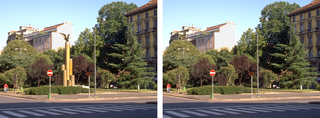











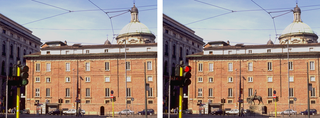


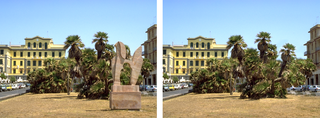

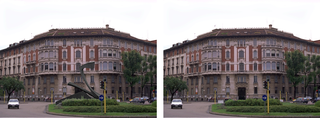




Social
Contatti
umberto@cavenago.info